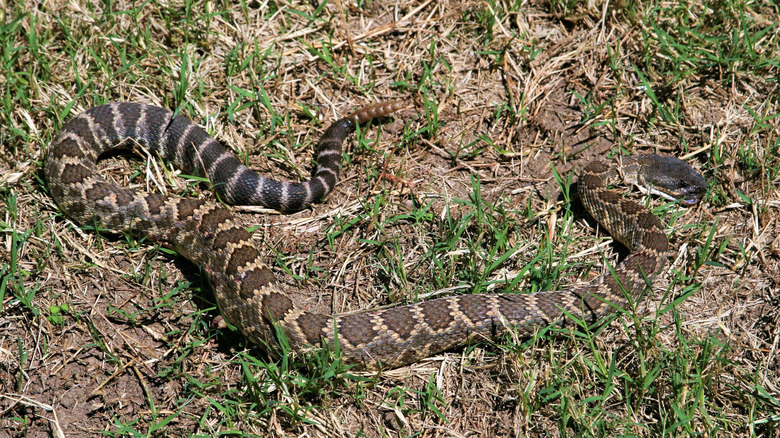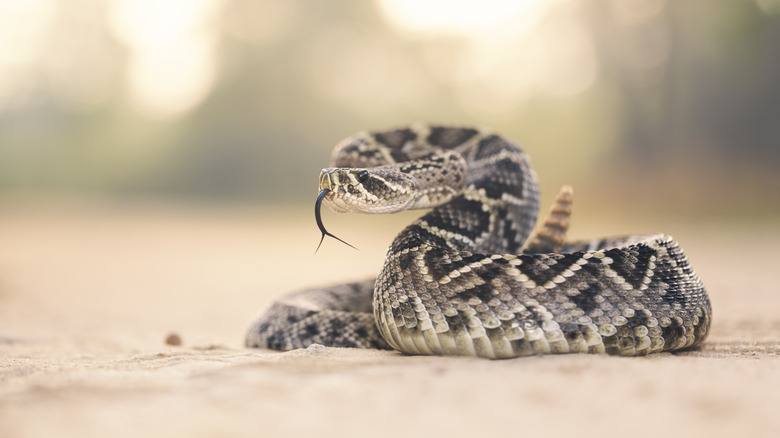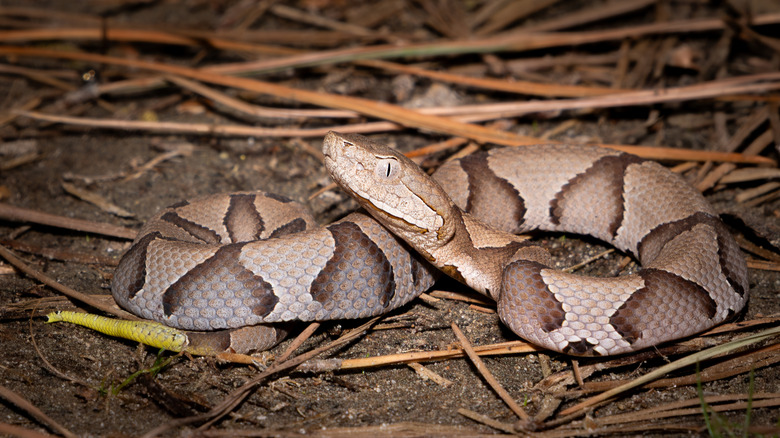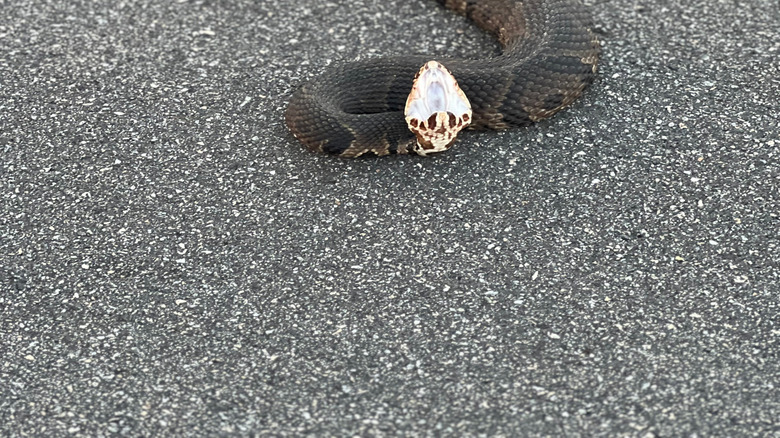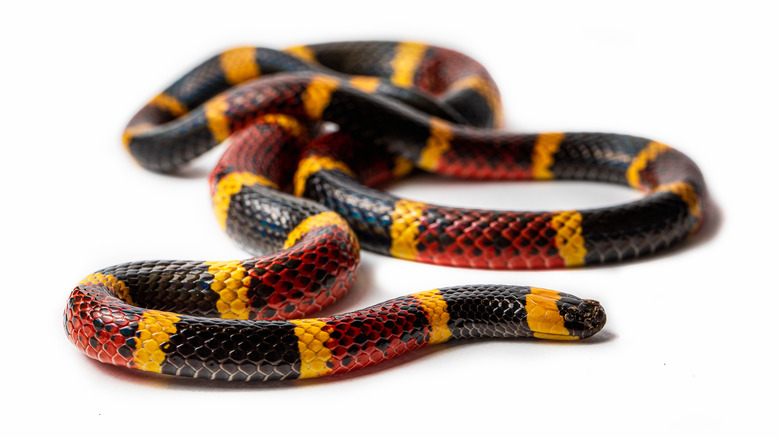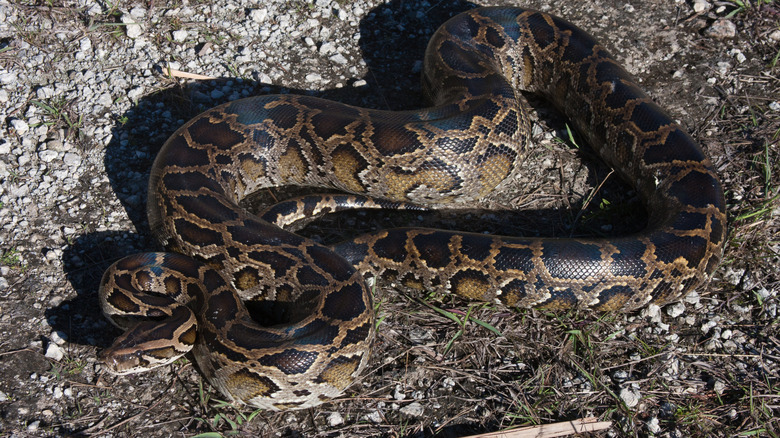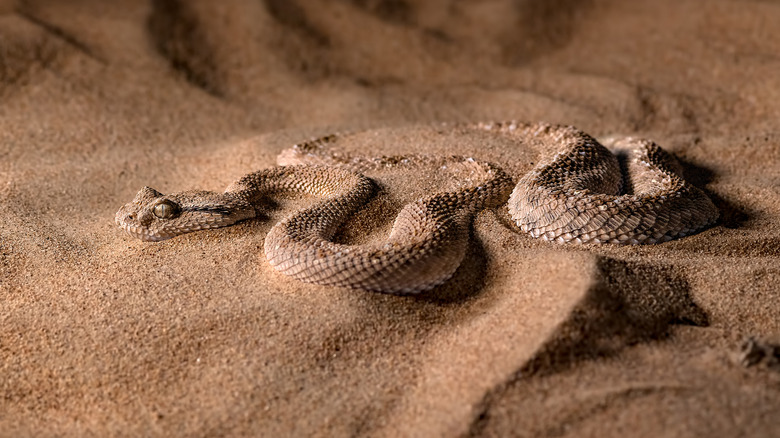6 Snakes You Do Not Want To See In Your Yard
Sometimes, having snakes that won't stay out of your yard isn't such a bad thing (if you don't mind snakes, that is). But if you see any of these six snakes, this is not one of those times. The chances of having anything other than a tiny garter snake hiding in your backyard in most places in suburbia are already slim, but if a king snake or a corn snake does show up, they are typically docile and will help keep the rodent population in your yard low. They also don't constrict, nor do they have enough venom to harm you (if any), so they aren't a big risk to you or your pets. However, if a venomous snake shows up, it's another story.
These snakes can pose a real risk to your safety. In some states, there is also a large population of invasive constrictors that are big enough to threaten even large dogs. If you see any of these on your property, it's best to call a professional wildlife handler to remove them. Often, people will kill snakes themselves with a shovel, not realizing that even venomous snakes are an important part of the local ecosystem. Plus, in some cases, the severed head of a snake can still deliver venom, as the nervous system can still be active. Even though few Americans die each year due to snake bites, it's only because of medical treatment being so widely available. Most snake bites are still painful and debilitating, so it's best to keep yourself and your pets away from the reptiles. These are the snakes you'll want to keep from slithering around in your yard.
Rattlesnakes are common in the Southwest
There are many different species of rattlesnakes in the United States, but they all share similar characteristics. They are pit vipers, which means they have heat-sensing pits near their eyes that help them discover and track the warmth of their prey. They have very thick, heavy bodies with rough scales that often match the coloration of the landscape they live in. This can make them very hard to spot. However, rattlesnakes do have a generous warning system built in — the interlocking scales at the tip of their tail that give off a loud rattle when their muscles constrict. Rattlesnakes are known to be a bit mean, but only when cornered. If you leave them alone, you won't have an issue, as they want you to stay far away (hence the rattle). Yet, they are all also highly venomous, which makes them a threat to both humans and pets alike.
Because of their shyness, you are most likely to find them somewhere cool, where they can hide from the heat of the day. Common spots are under decks, around rock gardens, or near sheds, especially if there is a woodpile. To keep them from hanging around, seal up gaps under sheds, decks, and steps. You can also install rattlesnake-proof fencing — a fine mesh that's buried a few inches into the ground and angled outward. Pets can also receive rattlesnake vaccines if you live in an area with a lot of them as a precaution.
Copperheads are typically found in the American east
Copperheads are medium-sized snakes, usually measuring between 2 and 3 feet long, with stout bodies and triangular heads, characteristic of pit vipers. Their eyes have vertical slit pupils, giving them a somewhat menacing look. Copperheads get their name from their copper appearance. Their main scales are a rich, coppery-brown color, and they have hourglass-shaped bands that are a touch darker. This helps them blend in with fallen leaves. They often rely on this camouflage to avoid detection and will usually freeze rather than flee when they sense danger. However, because they blend in so well, it can be hard to spot them in a messy yard. This leads to bites when you (or a pet!) accidentally steps on one or approaches a hidden snake too closely.
They are venomous and pose a threat to people and pets. If you spot one in your yard, don't approach it or try to kill it yourself, as even an injured snake can still bite you. You'll usually find copperheads in and around piles of leaves, wood, and other yard debris where they can hide. To make your yard less inviting to copperheads, keep your grass mowed short and remove these piles. They also love eating rodents, so if your property has less food available for them, they might not hang around. This includes filling in gopher holes, which could be encouraging snakes to take up residence.
Cottonmouths/water moccasins are most prevalent in the Southeast
These snakes are familiar to most southerners as they often show up in slow-moving bodies of water. Each lake, pond, and bayou typically has a few calling it home, and the snakes have even been known to visit swimming pools if you live near marshland. After flooding, cottonmouths sometimes travel overland and could appear in places they normally wouldn't. When they are babies, they have yellow-tipped tails to help them catch prey by luring them in. As they age, they get quite big — about 2 to 4 feet long — and have thick, heavy bodies. Their scales are brown, but range in hue. However, what they all have in common and where they get one of their names is their bright white mouths. They display it in a threatening "gape" when they feel cornered, even though they might not move away when you approach them. In fact, of all the venomous snakes in the U.S., they rank among the most dangerous, because of their tendency to not back down, which a pet or child might misinterpret.
Their venom is highly potent and poses a threat to people and pets. If you have any bodies of water on your property, always watch your step near its edge, especially around muddy banks or anywhere with taller grass. It's best to wear long pants and thick boots if you plan to do yard work in an environment like this. Cottonmouths love wet, shady environments and will often be found basking near the edges of water.
Coral snakes also live in the east
These snakes are bright, almost tropical-looking, and are easily recognized by their striking color pattern of red, yellow (or white), and black bands. These snakes are made most famous by the rhyme to set them apart from the kingsnake, which is relatively harmless. Remember, "Red and yellow, kill a fellow; red and black, venom lack." These are thin snakes, but can grow quite long. They have rounded heads that aren't much wider than their necks. They are shy and like to spend most of their time avoiding would-be predators. You'll find them near woodpiles, rock gardens, or especially compost heaps. Coral snakes also like to burrow, so you might find them under mulch or in more marshy spots.
Because they are so secretive, it's unlikely you'll ever just see them out and about. So if you need to lift a log, board, or anything lying flat on the ground, always use a long stick or tool to flip it toward you, not away from you. This way, if a snake (or any other critter) is hiding underneath, it will be forced to move away from you. While they are shy, their venom is very, very strong and contains a neurotoxin that can affect your nervous system and cause respiratory failure. If a human or pet is bitten, you must seek emergency medical care ASAP. So, if you see one in your yard, don't pick it up.
Invasive pythons are all over Florida
Invasive Burmese pythons are unfortunately a major problem in Florida, particularly in the south of the state near the Everglades. They are top predators in areas where they have no natural enemies, so each year, their numbers grow and the population expands north. The state has even set up a special bounty system in an attempt to reduce their numbers. While these snakes are not venomous, they are physically enormous, often growing longer than 15 feet. They have thick, muscular bodies covered in tan, brown, and black blotches that help them blend in with the swampy environment, similar to camouflage patterns. They are also very hungry, and since they have been known to eat alligators, can easily make a snack out of your pets.
If you're in South Florida, especially near wetlands, canals, or nature preserves, it's a good idea to keep an eye out for shed python skins because finding one nearby could mean a python is living close. If you do see one, report the sighting immediately. You can call the Exotic Species Hotline at 1-888-IVE-GOT1 (1-888-483-4681) or use the "IveGot1" app to quickly report invasive species sightings. Officials track these reports to control the population. Don't try to capture it yourself, as these snakes are even stronger than they look and could easily wrap themselves around you before you know what's happening. We can't all be Steve Irwin, so leave it to the professionals.
Sidewinders are found in certain areas of the Southwest
Sidewinders are a type of rattlesnake, but look a bit different than other species due to the little "horns" above their eyes. They also move a bit differently. They are typically found in high desert parts of southern California, Arizona, and Nevada. While it's unlikely for them to end up in your backyard, a few have been known to show up on occasion. They get their name from the way they "sidewind" by lifting parts of their body off the ground and moving sideways, which helps them move quickly over the hot desert sand. If you have any sand landscaping in your yard, you will know if there is one around because of the "J"-shaped pattern it leaves on the ground. If you actually see one, you can identify it by its sandy or pale brown color with darker brown or gray blotches running along its back.
However, they might be hiding in a sneaky spot around your yard. These snakes are quite shy and are very small compared to other rattlesnakes. Their venom is also less potent and is more likely to cause local tissue damage and pain than any long-lasting neurological damage. However, for smaller dogs, especially prey-driven, curious breeds like terriers and corgis, they might pose a particular danger because of these dogs' instinct to hunt and chase.
